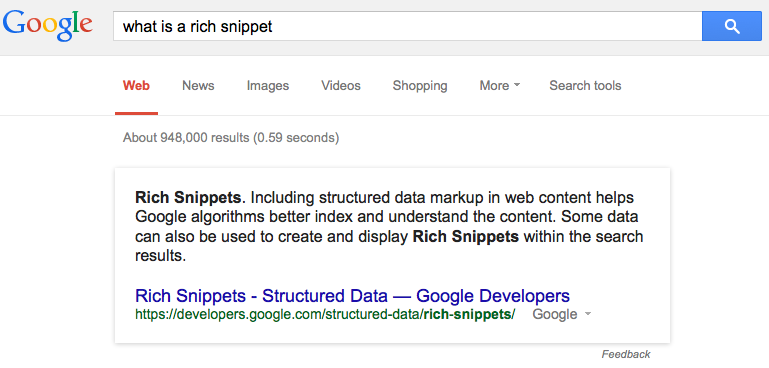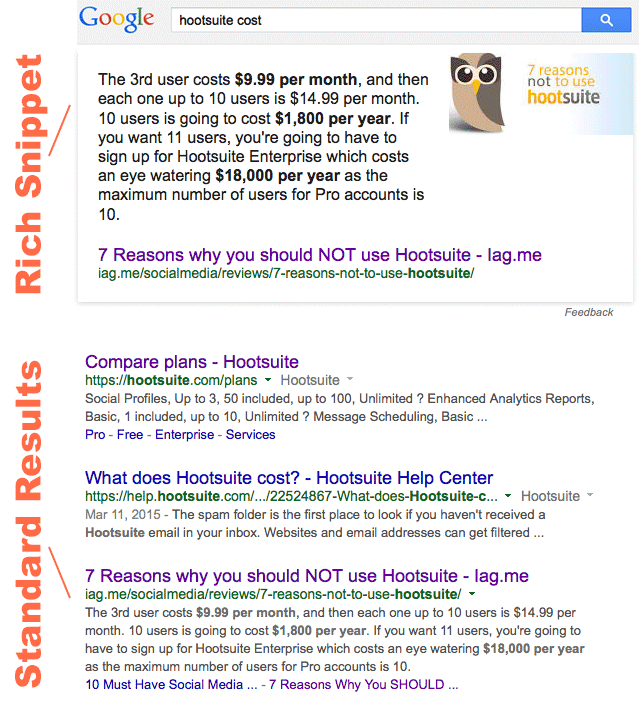Questions & Topics Covered In This Article:
- What is Structured Data and Schema.org?
- Do Rich Snippets Capture Attention?
- How does Structured Data work?
- Is Structured Data the next big opportunity for Web Content Marketing
- Rich Content Leads To Visitor Engagement
- Does Structured Data improve SEO Results?
What is Structured Data and Schema.org?
The term Structured Data may be new to many marketers. From a very high level, structured data in the context of this article refers to content markup that makes web content more “understandable” to search engines like Google.
There are different “flavors” of structured data, and this article will focus on a one special type of structured data defined by Schema.org, a collaboration between Google, Microsoft, Yahoo! and Yandex. The goal of that collaboration is to help search engines understand the information on web pages to provide richer search results.
About Rich Snippets

The above search engine results show a block using what Google calls a Rich Snippet. Basically it’s a concise summary of content that is believed to be relevant to the user’s search. It is made possible when Google is able to understand the content on a page with enough confidence to enhance the presentation of that content to the person making the search.
That “Google confidence” is driven by that complex algorithms that look at many SEO factors about the page, but ALSO by looking at the structure of specific content on the page itself.
A few years ago Google introduced a webmaster tool called the Data Highlighter designed for a webmaster to help Google understand page content as an enabler for rich snippets like the one above. Structured Data is effectively the successor to that tool, providing much greater capabilities to help enhance the understanding of your content across all major search engines.
Which of these search results would Capture YOUR Attention?
Below are 2 examples of search results for the same exact web page. The first one shows the typical formatting we have all become accustomed to seeing and the second is enhanced using a Rich Snippet.
Special Note:
There are a couple of things particularly interesting about the above search results. First, the rich snippet was shown more prominently than Hootsuite’s own content. Also note that according to Moz, the Hootsuite’s Page Authority is almost twice that of Ian Anderson Gray’s iag.me page (80 vs 42). What does all that mean? In this case the relevance of the content seems to trump the strength and relevance of the domain itself. Obviously Hootsuite is the authority on what it’s product costs. Yet Google must have concluded that the iag.me page had enough credibility and greater relevance to the user than Hootsuite’s own content. (It is also possible the somewhat controversial twist iag.me used was also a factor, which has generated some impressive engagement if you look at the volume of comments and shared on the article)
How does Structured Data work?
Just like Page Numbers, Chapters, and a Table of Contents are familiar elements that make a book easier to read, Structured Data allows marking-up your web page content using a predefined “vocabulary” and rules. One such vocabulary is defined by schema.org and provides a very rich set of tagging entities that may be used to mark up everything from generic web pages, to legal services, self-storage, medical articles and much more.
These rules can define the content or types of data, and the relationships between them. That defined structure then makes it easier for search engines to understand and properly index the content. So while the above mentioned book attributes are designed for a human reader, structured data tags are designed to be used by search engines.
The concept is similar to HTML tagging where, for example, an <H1> tag is recognized by all common browsers to be formatted as a heading. Structured data is a next generation markup that even further explains your content, allowing you to more clearly identify a company’s phone, job title, or blog article author for example.
When Google is able to better understand the content of your page, it can do some pretty interesting things with that content.
A big opportunity for Web Content Marketing
You may be curious about the adoption of Structured Data within current websites. The graph shown below illustrates search interest trends (USA searches) for the terms Structured Data versus Rich Snippets.
Google Trends – USA Search Interest For “Structured Data”†

†As you can see, there is clearly a growing interest in structured data since mid 2011 and a decline in searches for Rich Snippets. Also note that it was June 2, 2011 that Google made an official announcement about the formation of schema.org ( Introducing schema.org: Search engines come together for a richer web ).
Engaging Visitors With Rich Content
Although it may seem that more traffic is the right end goal for your SEO efforts, more of the RIGHT traffic will usually produce much more favorable results. Why? Because attracting the wrong visitors to your site, does not generally produce real engagement – it produces bounces. Bad for the visitor, BAD for your SEO.
For example, if you “trick” someone into clicking to your page with a compelling headline, but the content is not really relevant to what they are searching for, it will most likely result in a bounce. A bounce is a red flag for Google (or at least a “yellow flag” – there are cases where the visitors get’s what they need via the single page, i.e. the company phone number, or a question answered, etc.).
Competitive Opportunity
Could the early adoption of structured data within your website provide a strategic advantage for your business?So what most website owner’s should really be looking for are visitors who engage in a meaningful way – they buy your product, social share your page, or any other goal that you are trying to facilitate. That is meaningful engagement.
With a goal for engagement in mind, your web strategy should then be to get more visitors who are actually looking for your specific content, product or services. Then when a search engine like Google is then able to use structured data to enhance the presentation your content, you win. That content can then become more compelling to the searcher, and more compelling typically means higher click-through rates!
Does Structured Data improve SEO Results?
According to Google’s FAQ on this Google Webmaster Tools Page:
“Will using schema.org improve my site’s performance in search?”
Google doesn’t use markup for ranking purposes at this time—but rich snippets can make your web pages appear more prominently in search results, so you may see an increase in traffic.
UPDATE: Up until early 2015, Google has clearly stated that schema markup is not used by Google for ranking purposes BUT your site may get an increase in traffic because of it. Interestingly, the above page has been taken down by Google sometime around March 2015. The fact that this statement is no longer on the new page may just be an oversight, or could it possibly mean that schema markup WILL BE A RANKING FACTOR sometime soon? I will be interested to hear your thoughts on this so please leave a comment if you have an opinion.
Note: You can still see a cached copy of the page here from the 2/14/2015 archive (click “Will using schema.org improve my site’s performance in search?” toward the bottom of the page).




Leave a Reply